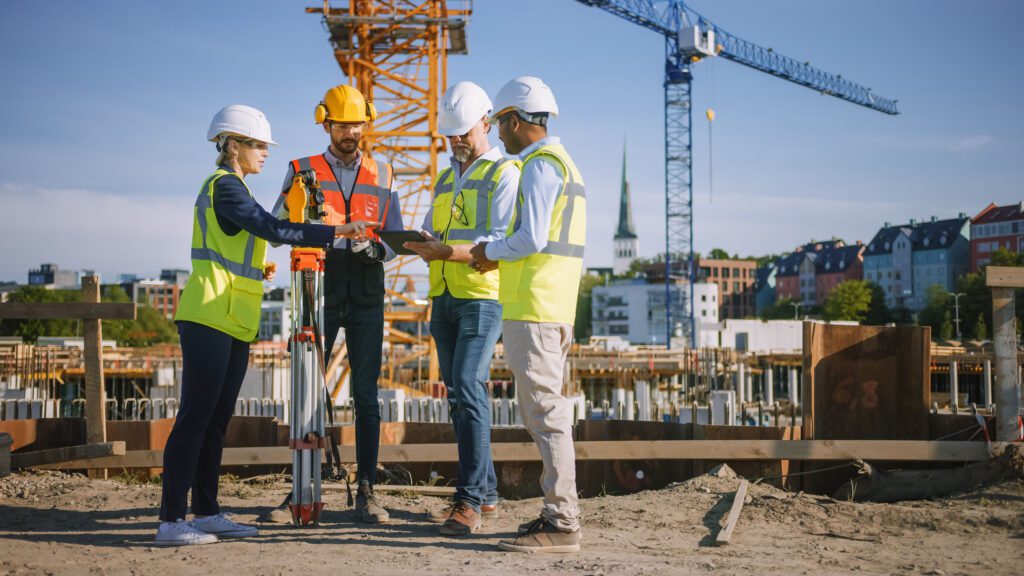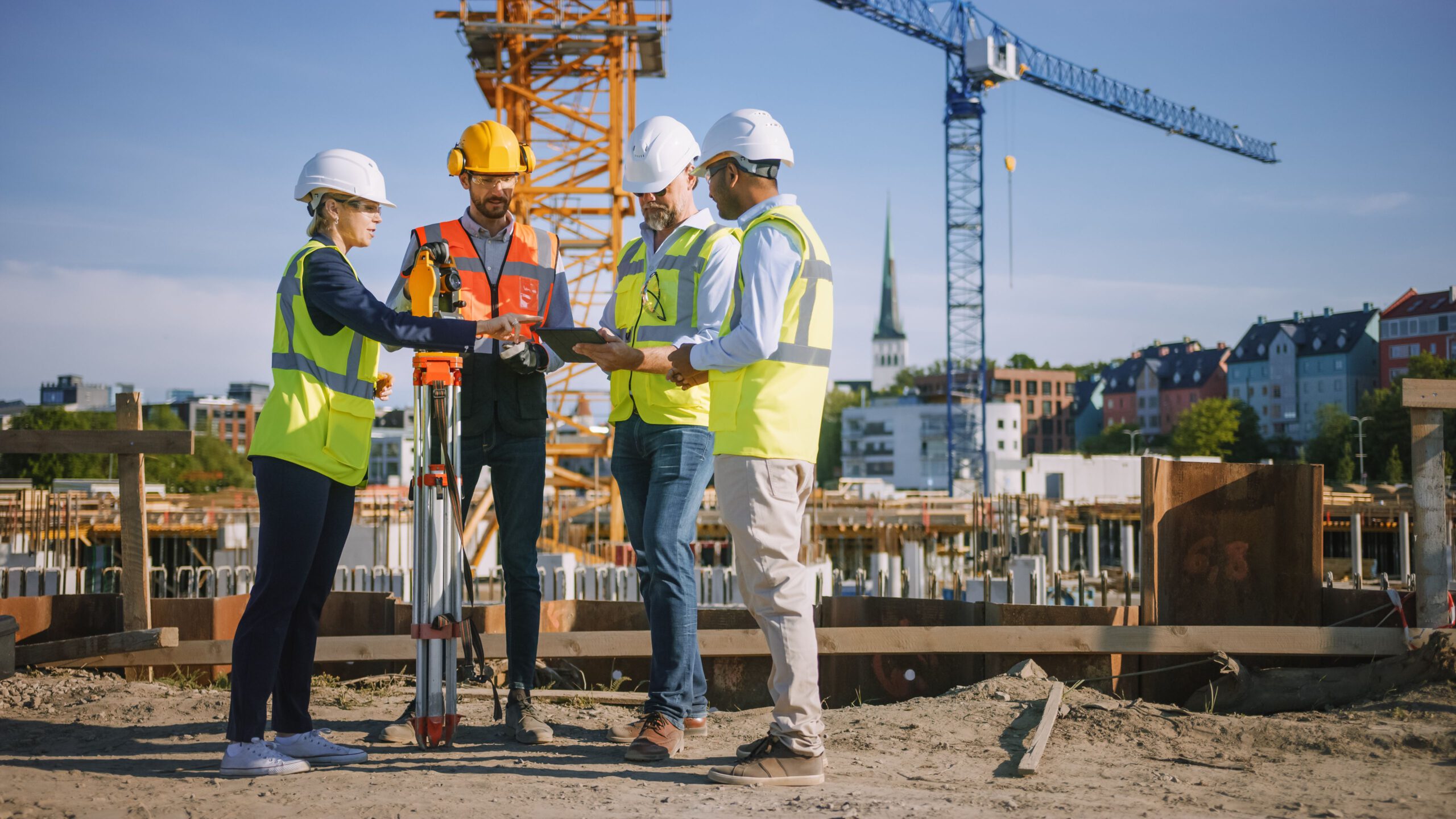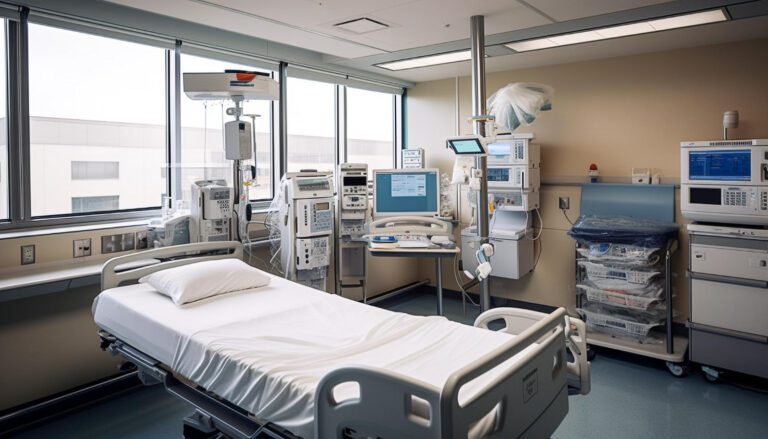
Healthcare construction trends involve the building and updating of medical buildings like hospitals, clinics, and labs. They are super important in healthcare because they affect patient care quality and how efficiently healthcare services are provided. Recent years have seen various trends influencing how healthcare facilities are planned, built, and run.
Table of Contents
- 0.1 Overview of Top Healthcare Design Concepts
- 0.1.1 Integration of natural and healing environments in medical facilities
- 0.1.2 Emphasis on flexible spaces to accommodate future needs
- 0.1.3 Incorporation of telehealth capabilities in healthcare design projects
- 0.1.4 Focus on creating patient-friendly spaces with improved wayfinding systems
- 0.1.5 Use of modular construction techniques for faster project completion
- 0.2 Importance of Safe Design in Healthcare Facilities
- 0.2.1 Preventing the spread of infections within healthcare settings
- 0.2.2 Minimizing risks associated with medical errors through proper layout planning
- 0.2.3 Enhancing staff efficiency and workflow through optimized design
- 0.2.4 Adhering to regulatory guidelines for safe healthcare facility operations
- 0.2.5 Creating a comfortable environment that promotes healing and well-being
- 0.3 Key Considerations for Safe Healthcare Facility Design
- 0.4 Key Components of a Successful Healthcare Construction Project
- 0.5 Recommendations for the Safety Culture and Design Process
- 0.6 Conclusion
- 0.7 Frequently Asked Questions?
- 0.7.1 What are some key factors to consider when designing a healthcare facility?
- 0.7.2 How can technology improve healthcare facility design?
- 0.7.3 What are some current trends in healthcare facility design?
- 0.7.4 How can healthcare construction projects attract private hospital investors?
- 0.7.5 What role do contractors play in healthcare facility design and construction?
- 1 Subscribe to our Newsletter
Healthcare Construction Trends and Technology
Technology has revolutionized the construction industry, and the healthcare sector is no exception. The use of advanced technology can greatly enhance the construction process in healthcare facilities. Here are some examples of healthcare construction technology:
- Building Information Modeling (BIM) allows for creating 3D models that provide a detailed visualization of the project. This helps identify potential design flaws and optimize space utilization.
- Prefabrication and Modular Construction: Prefabrication involves constructing components off-site and assembling them on-site. This method reduces construction time and minimizes disruptions to ongoing healthcare operations.
- Virtual Reality (VR) and Augmented Reality (AR): VR and AR technologies enable stakeholders to experience a virtual walkthrough of the healthcare facility before construction begins. This allows for better visualization and the identification of design issues.
- Robotics and Automation: Robots and automated systems can be used for various tasks in healthcare construction, such as bricklaying, painting, and material handling. This improves efficiency and reduces the risk of human error.
- Sustainable Construction Practices: Technology can be utilized to implement sustainable construction practices, such as energy-efficient lighting systems, smart HVAC systems, and renewable energy sources. This promotes environmental responsibility and reduces long-term operational costs.
By incorporating these technologies into healthcare construction projects, the industry can benefit from improved efficiency, cost savings, and better patient outcomes.
As you embark on your journey to build a new healthcare facility, we understand the importance of creating an environment that prioritizes patient well-being and delivers exceptional care. The demand for healthcare facilities worldwide is growing rapidly, driven by an increasing focus on patient-centered design and the need for advanced medical services. The healthcare construction industry has faced unique challenges and opportunities in light of recent events such as the COVID-19 pandemic.
We will delve into topics such as sustainable and energy-efficient designs, the role of technology in improving construction processes, and the vital collaboration between architects, contractors, and medical professionals.
Overview of Top Healthcare Design Concepts
Healthcare design projects are pushing the boundaries of innovation by incorporating cutting-edge technologies. These projects aim to revolutionize patient care and improve overall healthcare outcomes. One such example is the use of robotic surgical systems, which allow for more precise and minimally invasive procedures. These systems enable surgeons to perform complex surgeries with greater accuracy, resulting in reduced recovery times and improved patient satisfaction.
Another exciting technology being integrated into hospital designs is virtual reality (VR). VR can be used to create immersive experiences for patients, helping to alleviate anxiety and pain during medical procedures. By transporting patients to calming virtual environments, healthcare facilities are enhancing the healing process and promoting a sense of well-being.
Integration of natural and healing environments in medical facilities
In recognition of the therapeutic benefits of nature, healthcare design projects are increasingly incorporating elements that bring the outdoors inside. This integration promotes healing by creating a serene and calming environment for patients. For instance, hospitals are implementing rooftop gardens, indoor green spaces, and natural light sources to enhance patient comfort.
Furthermore, biophilic design principles are employed to maximize the connection between humans and nature. By integrating natural materials like wood and stone into the architectural elements of medical facilities, designers are creating a harmonious atmosphere that promotes relaxation and reduces stress levels.
Emphasis on flexible spaces to accommodate future needs
With rapidly evolving healthcare requirements, it is crucial for medical facilities to have flexible spaces that can adapt to changing needs. Project designers prioritize modular layouts that allow for easy reconfiguration as technology advances or patient demographics shift.
Flexible spaces also facilitate collaboration among healthcare professionals by providing adaptable work environments. For example, shared workstations equipped with state-of-the-art communication tools enable seamless interaction between doctors, nurses, and other staff members. This flexibility enhances teamwork and ultimately improves patient care.
Incorporation of telehealth capabilities in healthcare design projects
The rise of telehealth has revolutionized the way healthcare services are delivered. In response, healthcare design projects now incorporate dedicated spaces for virtual consultations and remote patient monitoring. These spaces feature advanced audiovisual equipment and high-speed internet connectivity to facilitate seamless communication between patients and healthcare providers.
By integrating telehealth capabilities into medical facilities, patients can conveniently access healthcare services from the comfort of their homes. This approach not only improves accessibility but also reduces the burden on physical infrastructure, allowing hospitals to optimize their resources more effectively.
Focus on creating patient-friendly spaces with improved wayfinding systems
Navigating through large medical facilities can be a daunting task for patients and visitors. To alleviate this challenge, healthcare design projects are prioritizing the implementation of improved wayfinding systems. These systems utilize intuitive signage, digital maps, and interactive kiosks to guide individuals seamlessly throughout the facility.
Patient-friendly spaces are also being created to enhance comfort during hospital visits. Waiting areas are transformed into welcoming environments with comfortable seating, natural lighting, and access to charging stations and Wi-Fi. Such improvements contribute to a positive patient experience while reducing stress levels associated with hospital visits.
Use of modular construction techniques for faster project completion
Traditional construction methods often result in extended project timelines, causing delays in delivering much-needed medical facilities. To overcome this challenge, project designers increasingly turn to modular construction techniques.
Modular construction involves fabricating building components off-site in controlled factory conditions before assembling them on-site. This approach significantly reduces construction timeframes while maintaining quality standards. By adopting modular techniques, hospitals can be built more efficiently, ensuring timely delivery of essential healthcare infrastructure.
Importance of Safe Design in Healthcare Facilities
Patient safety is of utmost importance in healthcare facilities, and it begins with the design process. By carefully considering the layout and functionality of a healthcare facility, designers can create an environment that minimizes potential risks to patients. This involves implementing strategies such as clear wayfinding signage, well-lit corridors, and ergonomic furniture to prevent accidents and falls.
Designing spaces that promote infection control is crucial for patient safety. Incorporating features like antimicrobial surfaces, proper ventilation systems, and designated areas for hand hygiene can help prevent the spread of infections within healthcare settings. By prioritizing these aspects during the project design phase, healthcare facilities can significantly reduce the risk of harm to patients.
Preventing the spread of infections within healthcare settings
One of the primary concerns in healthcare facilities is preventing the transmission of infections. A well-designed facility takes into account various factors that contribute to infection control. For example, designing isolation rooms with negative-pressure airflow systems can minimize the risk of airborne pathogens spreading from one patient to another.
Furthermore, incorporating easy-to-clean surfaces and materials reduces the likelihood of bacteria or viruses lingering on frequently touched objects or surfaces. The strategic placement of handwashing stations throughout a facility encourages proper hand hygiene among staff members and visitors alike.
Minimizing risks associated with medical errors through proper layout planning
Medical errors are a significant concern in healthcare settings and can have severe consequences for patients. However, by implementing effective layout planning during project design, many potential risks associated with human error can be minimized.
For instance, creating clear pathways for staff members helps reduce confusion and allows for efficient movement throughout the facility. Properly organizing equipment and supplies also plays a vital role in minimizing errors during critical moments in patient care. By placing essential items within easy reach and ensuring clear labeling systems are in place, healthcare professionals can navigate their workspaces more effectively, reducing the risk of mistakes.
Enhancing staff efficiency and workflow through optimized design
A well-designed healthcare facility not only benefits patients but also enhances staff efficiency and workflow. By optimizing the layout to support smooth operations, healthcare professionals can provide better patient care.
Design elements such as centralized nursing stations, strategically located storage areas, and efficient patient room layouts contribute to improved workflow. These features reduce unnecessary steps and minimize time spent on non-patient care activities, allowing healthcare professionals to focus more on delivering quality care.
Adhering to regulatory guidelines for safe healthcare facility operations
Healthcare facilities are subject to strict regulatory guidelines that ensure safe operations. Compliance with these regulations is crucial for maintaining patient safety and avoiding penalties or legal issues.
During the project design phase, it is essential to consider these regulations and incorporate them into the facility’s design. This includes aspects such as accessibility for individuals with disabilities, fire safety measures, and adherence to infection control standards. By proactively addressing these requirements during the design process, healthcare facilities can ensure a safe environment for patients and staff members.
Creating a comfortable environment that promotes healing and well-being
Beyond physical safety considerations, a well-designed healthcare facility aims to create a comfortable environment that promotes healing and well-being. Patients often experience stress and anxiety during their stay in medical facilities, so incorporating design elements that address these emotional needs is crucial.
For example, utilizing noise reduction strategies can help create a quieter environment that supports restful sleep and reduces stress levels. Incorporating natural lighting through large windows or skylights can enhance mood and positively impact patients’ overall well-being. Integrating soothing colors, artwork, or nature-inspired elements into the interior design can contribute to a calming atmosphere that aids healing.
Key Considerations for Safe Healthcare Facility Design
Proper ventilation systems are crucial for maintaining optimal air quality standards. The physical environment plays a significant role in preventing the spread of infections and creating a safe space for patients, healthcare professionals, and visitors.
A well-designed ventilation system should effectively circulate clean air throughout the facility while removing airborne contaminants. This can be achieved through the use of advanced filtration systems, such as high-efficiency particulate air (HEPA) filters, which can capture even the smallest particles. Incorporating adequate airflow patterns and ventilation rates helps minimize the risk of cross-contamination by preventing stagnant air pockets where pathogens can linger.
The facility design process should include a thorough assessment of ventilation needs based on factors like room occupancy, function, and potential sources of airborne contaminants. By following safety design principles and considering human factors such as patient vulnerability and staff workload, designers can create an environment that promotes optimal air quality and reduces the transmission of infectious diseases.
Effective space planning to minimize cross-contamination risks
Facility design plays a critical role in minimizing cross-contamination risks within healthcare settings. Proper space planning involves strategically allocating areas based on their specific functions while considering infection control measures.
One important aspect is separating different patient populations to prevent the transmission of contagious diseases. For instance, designing separate waiting areas or treatment zones for patients with respiratory illnesses can help contain potential outbreaks. Similarly, creating dedicated spaces for vulnerable patients with weakened immune systems or contagious conditions minimizes their exposure to pathogens.
In addition to patient segregation, effective space planning should consider workflow optimization and efficient traffic flow patterns. By carefully mapping out how healthcare professionals move through the facility during various procedures or emergencies, designers can identify potential bottlenecks or areas prone to cross-contamination risks. This information allows them to implement appropriate measures such as hand hygiene stations, designated clean and dirty zones, and clear signage to guide staff and visitors.
Implementation of infection control measures throughout the facility
Infection control is a critical aspect of healthcare facility design. Designers should integrate infection control measures into every aspect of the physical environment to create a safe space for patients, staff, and visitors.
One key consideration is the selection of appropriate materials that are easy to clean and disinfect. Surfaces that can withstand frequent cleaning with hospital-grade disinfectants help prevent the survival and spread of pathogens. Incorporating seamless finishes without crevices or joints reduces the risk of microbial growth in hard-to-reach areas.
Hand hygiene is another crucial element in infection control. Designers should ensure an adequate number of handwashing stations strategically located throughout the facility, including nearby patient rooms, waiting areas, and entrances/exits. Furthermore, incorporating touchless fixtures such as automatic faucets, soap dispensers, and paper towel dispensers can minimize cross-contamination risks.
By considering these infection control measures during the facility design process recommendations, designers can create a physical environment that supports effective infection prevention strategies while maintaining a comfortable space for patients.
Integration of technology solutions for enhanced security and surveillance
In today’s healthcare landscape, integrating technology solutions into facility design has become essential for enhanced security and surveillance. From access control systems to video monitoring tools, advanced technologies play a vital role in ensuring the safety of patients and healthcare professionals.
Access control systems provide secure entry points within medical facilities using key cards or biometric authentication methods. These systems restrict unauthorized access to sensitive areas while allowing authorized personnel seamless movement throughout the facility. Integrating visitor management systems helps track individuals entering or exiting the premises for better security management.
Video surveillance systems are also instrumental in maintaining a safe healthcare environment. Strategically placed cameras provide real-time monitoring capabilities that aid in preventing thefts, violent incidents, or unauthorized activities within the facility. Video surveillance can also assist in identifying potential infection control breaches and monitoring compliance with safety protocols.
By incorporating these technology solutions into healthcare design-build solutions, hospital investors and contractors can enhance the overall security and surveillance measures within medical facilities, ensuring a safer environment for everyone involved.
Incorporation of ergonomic features to reduce workplace injuries
The physical well-being of healthcare professionals is a crucial consideration. By incorporating ergonomic features into the workspace, designers can help reduce workplace injuries and improve staff comfort, ultimately enhancing patient care.
Basically, when people design healthcare spaces, they need to think about how to make it easier for doctors and nurses to do their jobs without getting hurt. This means adding things like special chairs and desks that are good for their bodies. When the staff is comfortable, they can take better care of patients.
Key Components of a Successful Healthcare Construction Project
Several key components can contribute to a healthcare construction project’s success, from careful planning and design to efficient project management and communication. Each element plays a crucial role in ensuring the project meets its objectives and delivers high-quality healthcare facilities. Here are some of the key components to consider:
- Thorough Planning: Thorough planning is essential before starting any construction project. This includes conducting a comprehensive needs assessment to determine the healthcare facility’s specific requirements. It also involves creating a detailed project timeline, budget, and scope of work to guide the construction process.
- Experienced Design Team: Engaging an experienced design team is crucial for a successful healthcare construction project. Architects, engineers, and other design professionals with expertise in healthcare facilities can ensure that the building meets all regulatory requirements, is functional, and promotes patient well-being.
- Effective Project Management: A well-organized and efficient project management team is essential to keeping the construction project on track. This includes overseeing the budget, coordinating with subcontractors, and ensuring timely task completion. Effective project management helps minimize delays and cost overruns.
- Collaborative Communication: Open and collaborative communication is key to the success of any healthcare construction project. Regular meetings and clear communication channels between the project team, stakeholders, and healthcare professionals can help address any issues or changes promptly and ensure everyone is on the same page.
- Adherence to Regulatory Standards: Compliance with regulatory standards is crucial in healthcare construction projects. Therefore, meeting codes and regulations ensures the safety of patients, staff, and visitors. Working closely with regulatory bodies and obtaining the necessary permits and certifications throughout the construction process is essential.
- Advanced Technology and Equipment: Integrating advanced technology and equipment into the healthcare facility is essential to provide the best patient care. From state-of-the-art medical equipment to advanced IT infrastructure, incorporating the latest technologies can enhance efficiency and improve patient outcomes.
- Sustainable Design: Incorporating sustainable design principles into healthcare construction projects can have long-term benefits. Energy-efficient systems, renewable materials, and waste reduction strategies not only reduce the environmental impact but also lead to cost savings and improved operational efficiency.
- Quality Control and Safety Measures: Maintaining high-quality standards and ensuring safety is paramount in healthcare construction projects. Implementing quality control measures and rigorous safety protocols helps prevent accidents, minimize errors, and ensure the longevity of the facility.
Healthcare construction projects can be successfully executed by considering these key components, resulting in functional, safe, and efficient healthcare facilities. From thorough planning and effective project management to collaboration and adherence to regulatory standards, each component contributes to the project’s overall success. Remember, a well-executed healthcare construction project ultimately benefits patients, healthcare professionals, and the community as a whole.
Recommendations for the Safety Culture and Design Process
Several key recommendations can make a significant difference in establishing a strong safety culture and effective design process. By implementing these recommendations, organizations can create a safer working environment and ensure their design processes are efficient and reliable.
Safety Culture Recommendations
- Leadership Commitment: It is crucial for leaders to demonstrate their commitment to safety by setting a positive example and prioritizing safety in all decision-making processes.
- Employee Engagement: Encourage employees to actively participate in safety initiatives by providing them with opportunities to provide feedback, suggestions, and ideas for improvement.
- Training and Education: Invest in comprehensive safety training programs to ensure that all employees have the necessary knowledge and skills to perform their tasks safely.
- Communication and Reporting: Establish clear communication channels for reporting safety concerns and incidents and ensure that all employees are aware of these channels and encouraged to use them.
- Continuous Improvement: Regularly review and evaluate safety procedures and protocols to identify areas for improvement and implement necessary changes.
Design Process Recommendations
- Risk Assessment: Conduct thorough risk assessments at each stage of the design process to identify potential hazards and develop appropriate mitigation strategies.
- Collaboration: Foster a collaborative environment where designers, engineers, and other stakeholders can work together to ensure that safety considerations are integrated into the design from the beginning.
- Design for Safety: Incorporate safety features and considerations into the design, such as ergonomic design principles, hazard identification, and risk reduction measures.
- Testing and Validation: Implement rigorous testing and validation processes to ensure the design meets safety standards and performs as intended.
- Documentation and Standardization: Maintain detailed documentation of the design process, including design decisions, safety considerations, and any changes made along the way. Standardize design processes to ensure consistency and reliability.
By following these recommendations, organizations can establish a strong safety culture and ensure that their design processes prioritize safety. This not only protects employees and stakeholders but also contributes to the organization’s overall success and reputation. Remember, safety should always be a top priority, and these recommendations can help organizations achieve that goal.
Conclusion
When talking about project design and healthcare construction, it’s important to consider how technology can improve medical facilities and planning. This means using the latest healthcare design-build solutions and collaborating with hospital investors and contractors. By doing this, we can create better healthcare spaces that meet the needs of patients and healthcare professionals. In essence, technology plays a crucial role in making medical facilities even better. This involves using the newest healthcare design-build methodology and working together with hospital investors and contractors. By doing so, we can create excellent healthcare spaces for patients and doctors.
Frequently Asked Questions?
What are some key factors to consider when designing a healthcare facility?
When designing a healthcare facility, several factors need to be considered. These include patient safety, infection control measures, accessibility for individuals with disabilities, efficient workflow for staff members, flexibility for future expansion or changes in medical technology, and creating a welcoming environment for patients and their families.
How can technology improve healthcare facility design?
Technology plays a crucial role in improving healthcare facility design. It enables the implementation of advanced systems for patient monitoring, electronic health records management, telemedicine services, energy-efficient infrastructure, and smart building automation. Integrating technology into the design process enhances efficiency, improves patient outcomes, and provides an overall better experience for both patients and healthcare providers.
What are some current trends in healthcare facility design?
Current healthcare facility design trends include creating flexible spaces that can adapt to changing needs or accommodate different medical specialties within one building. Other trends include incorporating natural elements, like green spaces or healing gardens, into the design to promote wellness and healing. There is an increasing focus on sustainable practices such as using eco-friendly materials and energy-efficient systems.
How can healthcare construction projects attract private hospital investors?
To attract private hospital investors, healthcare construction projects need to demonstrate a strong potential for financial returns and long-term viability. This can be achieved by conducting thorough market research, developing a comprehensive business plan, showcasing the project’s unique selling points, and providing evidence of demand for the services the facility will offer. Highlighting any partnerships or collaborations with reputable healthcare providers can instill confidence in potential investors.
What role do contractors play in healthcare facility design and construction?
Contractors are essential partners in healthcare facility design and construction. They bring expertise in managing complex projects, coordinating various trades, adhering to strict timelines and budgets, and ensuring compliance with building codes and regulations. Contractors work closely with architects, engineers, and other stakeholders to translate design concepts into physical structures that meet functional requirements while maintaining high quality and safety standards.



